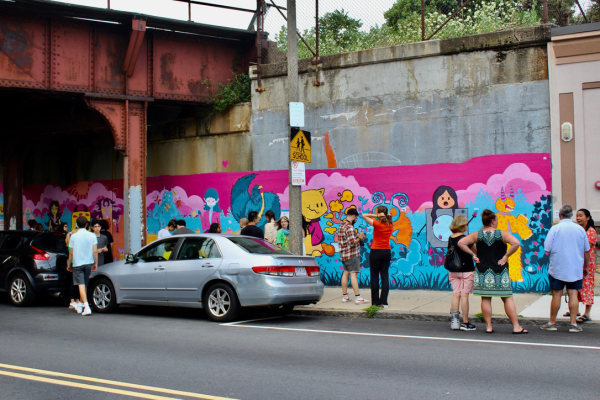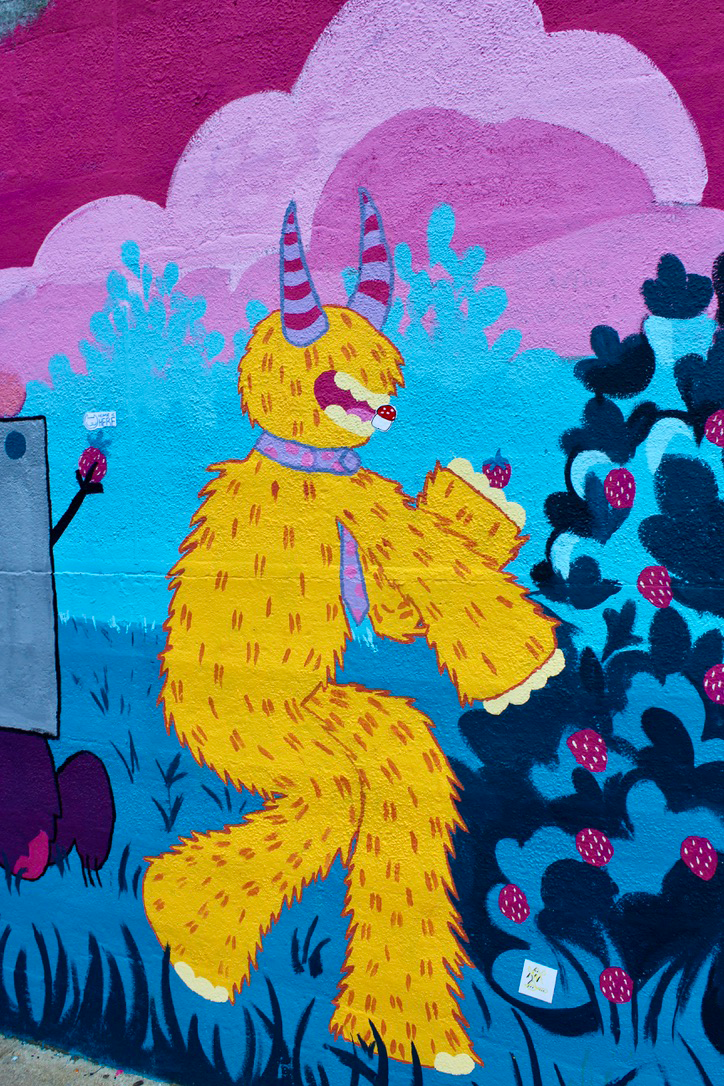July 25, 2024

Colorful creative art composed by young artists working with the Urbano Project fills the wall underneath and next to the Red Line tracks leading in and out of the Fields Corner station on Adams Street just south of the St. Ambrose church property. Cassidy McNeeley photos
Working underneath the Red Line tracks close to St. Ambrose Church on Adams Street, 11 young artists have spent the early part of their summer transforming a plain concrete wall into a colorful mural that represents their perceptions of home.
The artists, aged 14 to 21, spent six weeks in a placemaking study with Urbano Project, a non-profit that seeks to unite people through public art projects. This year’s summer program, instructed by the multidisciplinary visual artist Yixuan Zeng, was called “Home is Here.”
“The program was a combination of learning how to do urban sketching, which is drawing on location, and the second half was to design and complete the mural,” said Zeng. “I wanted [the artists,] through urban sketching, to reexamine, or explore their concept of home and bring those ideas into the mural that they designed.”
While Zeng and several of the students call Dorchester home, others ventured from others sections of the city to the program’s workspace at Brains Art Org (BAO) at 1443 Dorchester Ave., BAO is an equity-focused arts advocacy organization, and Urbano, a “nomadic non-profit,” rented the space therefor the summer mural-making program.
“We go to different art spaces like this wonderful place and we collaborate with a lot of different communities and organizations,” explained Urbano founder and executive artistic developer, Stella Aguirre McGregor.

Brazilian-born Agatha Dorigo, 21, was one of the students on the project. “When we conceptualized the mural, we took into consideration our personal perceptions of home and community,” said Dorigo. “We knew we wanted to incorporate things such as nature food and activity. That’s what we ended up working together on as these are integral aspects of how we experience the comfort of home regardless of where we are.”
When it came time to designing the mural, it was up to Dorigo and the rest of the students to make it happen.
“We wanted the mural to be around the community, but I also wanted to give the kids full agency in designing it,” said Zeng. “I did not want to dictate what they had to draw, I wanted them to go through the entire process of coming up with a concept themselves, the individual designs themselves, and then putting it all together.”
In the end, the students decided that they would paint monsters that represented themselves and then connect them in a picnic garden scene.
Noted Dorigo: “Yixuan used our sketches to create a mock-up mural in Photoshop, which helped us visualize the final product, and then we worked together to select the color pallet and gather supplies. Then we were finally ready to disembark on our grand journey.”
Dorigo’s monster, Ezra, is a cross between an insect and a mammal. Painted in shades of purple and peach, it can be found in the mural sipping on Dorigo’s comfort drink, boba.

“I specifically selected elements that spoke to my lived experiences so this monster could be a good representation of myself,” said Dorigo. “I wanted the monster to be a safe space for others to completely express themselves and live their full truth.”
Working on the mural allowed Dorigo and the rest of the class to learn about themselves and grow as artists. Said 18-year-old Miguel Estrada: “Some of the biggest points I will take with me further in my artistic career would be the respect for physical spaces I draw. This program has taught me that everywhere I go to create has been and always will be a home to someone, so it is always important to respect the architecture, the community, and the air we breathe because it means something to someone.”
Estrada, who will be a sophomore at Wesleyan University this fall, spent the first half of his life in Guatemala. Though he now resides in Hyde Park, his monster “Zara” represents his Latin American roots.
Like Dorigo, Estrada enjoyed working with Zeng, who became a mentor for each participant. Urbano programs director, Sterre Boerkamp described Zeng as a “role model for our youth both in their artistic quality and in their kind personality.”
Zeng hopes that if the students take away one thing it’s that “they have a lot of power to beautify the neighborhood and have an actual impact on places. I hope that it empowers them to know that they were able to make something that resonates with the community and with other people and inspires anyone that sees their art.”


